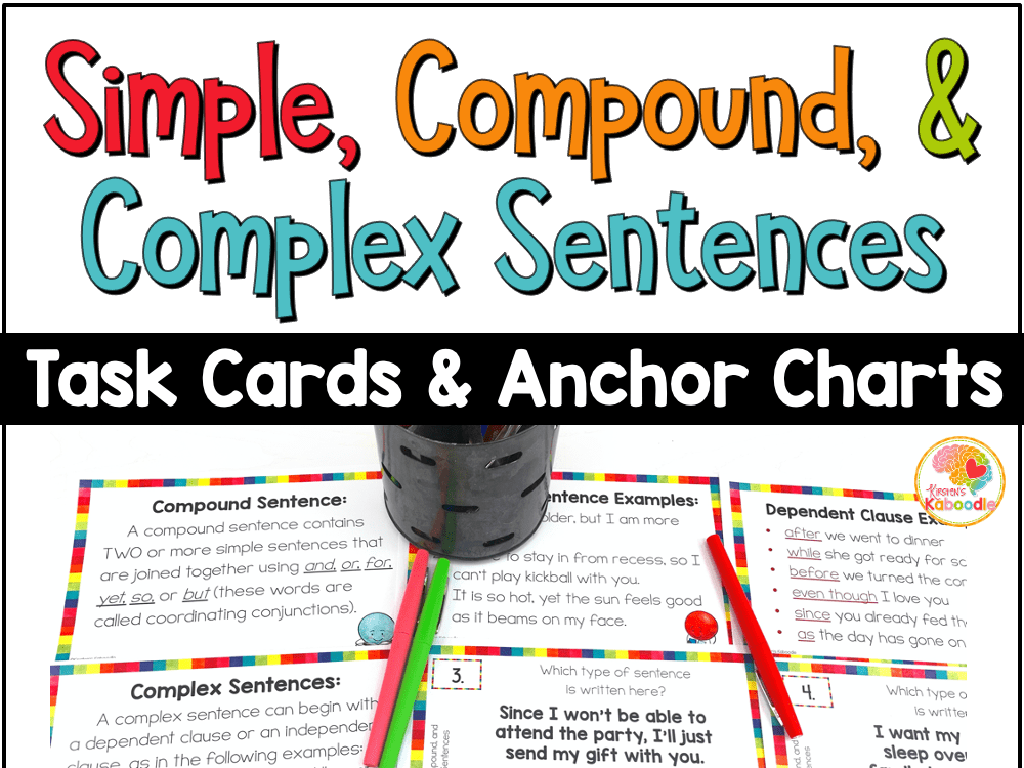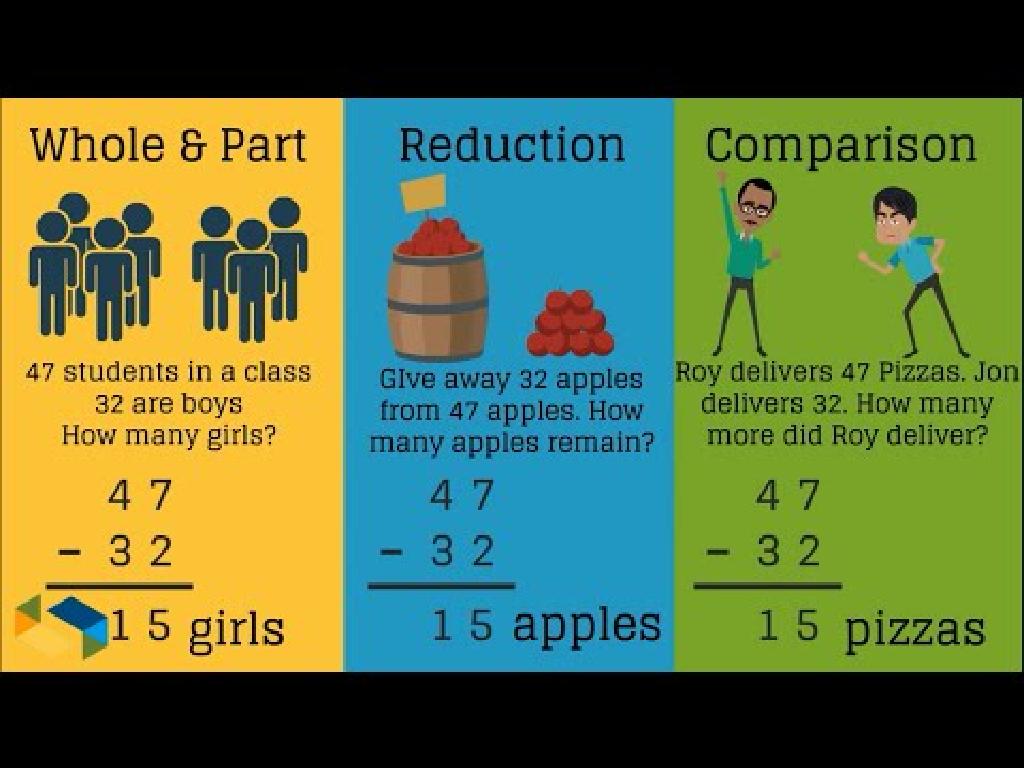Use Compensation To Subtract On A Number Line - Up To Two Digits
Subject: Math
Grade: Second grade
Topic: Subtraction Strategies: Two Digits
Please LOG IN to download the presentation. Access is available to registered users only.
View More Content
Welcome to Subtraction Strategies!
– Learn a cool way to subtract
– Subtraction means taking away
– Like if you have 5 apples and eat 2, you have 3 left!
– Use a number line for help
– A line with numbers that shows the distance between them
– Practice with two-digit numbers
– Try subtracting 34 – 12 on the number line!
|
This slide introduces second graders to the concept of subtraction using compensation on a number line. Start by explaining subtraction as a way of finding out how many items are left after some are taken away. Use relatable examples like toys or candies to illustrate this point. Introduce the number line as a visual tool to help them understand and perform subtraction. Show them how to move backwards on the number line to subtract. Provide several examples with two-digit numbers and guide them through the process of using compensation to make subtraction easier. For instance, if subtracting 34 – 12, show how to round 34 to 30, subtract 10 to get 20, and then adjust for the compensation. Encourage students to practice this strategy with different numbers and prepare for hands-on activities during the next class.
Understanding Compensation in Subtraction
– What is compensation?
– A trick to make numbers friendlier for math
– It’s a math balancing act
– Like giving and taking to even things out
– Adjust numbers to simplify
– Change numbers up or down to subtract easily
– Use on a number line
|
Compensation is a subtraction strategy that helps make mental math easier for second graders. It involves adjusting numbers to make them round or easier to work with before performing the subtraction. For example, if subtracting 8 from 23, we can round 23 up to 25 (compensating by adding 2), subtract 8 to get 17, and then take away the extra 2 we added. This slide will introduce the concept of compensation and how it can be applied to a number line, providing a visual aid for students to understand the process of balancing numbers to simplify subtraction. Encourage students to practice with two-digit numbers and use compensation to find answers more quickly.
Subtraction with Number Lines
– What is a number line?
– A line with numbers at equal spaces
– Visualizing number distances
– Shows how far apart numbers are
– Subtracting with leftward hops
– Move left to subtract numbers
– Practice with two-digit numbers
– Let’s try 54 – 29 with leftward hops
|
This slide introduces second graders to the concept of using a number line for subtraction, which is a part of learning subtraction strategies for two-digit numbers. Begin by explaining what a number line is and how it is organized. Emphasize that the spaces between numbers are equal, which helps us understand the distance between different numbers. Demonstrate how to subtract by moving to the left on the number line, as each hop represents taking away one unit. For practice, use an example with two-digit numbers, such as 54 – 29, and show how to make a big hop to subtract the tens and smaller hops to subtract the ones. Encourage students to draw their own number lines and practice subtracting with different numbers.
Subtracting with Compensation
– Making subtraction simpler
– Round numbers to subtract
– Change 29 to 30 to subtract from 53
– Example: 53 – 29
– Subtract 53 – 30 to find 23
– Adjust the answer after
– Add 1 back to 23 to get the correct answer
|
This slide introduces the concept of compensation in subtraction, a strategy to simplify the process for second graders. Explain that sometimes direct subtraction can be tricky, especially with two-digit numbers. To make it easier, we can round one number to a ‘nicer’ number, subtract quickly, and then correct our answer. Use the example 53 – 29 to illustrate this: round 29 up to 30, subtract to get 23, and then add the 1 we ‘borrowed’ to get the final answer, 24. Encourage students to practice this method with different numbers and ensure they understand the importance of adjusting their answer after the initial subtraction.
Let’s Practice Together: Using Compensation
– Example: 47 – 18 with compensation
– Step 1: Round 18 to 20
– Makes subtraction simpler
– Step 2: Subtract 47 – 20
– Result is 27, since 47 – 20 = 27
– Step 3: Add 2 back to the result
– Compensate for rounding, 27 + 2 = 29
|
This slide is an interactive class activity to practice the compensation strategy for subtraction. Start with the example 47 – 18. Explain that compensation means adjusting numbers to make mental math easier. In Step 1, round 18 up to 20, because it’s easier to subtract round numbers. In Step 2, perform the subtraction: 47 – 20 = 27. Finally, in Step 3, since we rounded 18 up by 2, we need to add those 2 back to our result, getting the final answer of 29. Encourage students to try similar problems and guide them through the steps. Possible activities include: using number lines, subtracting prices in a mock shopping scenario, or subtracting the number of days until a holiday or event.
Your Turn to Try: Using Compensation
– Practice compensation subtraction
– Round the number to subtract
If you have 52 – 29, round 29 to 30 to make it easier.
– Subtract the rounded number
Now subtract 52 – 30 instead of 52 – 29.
– Add back the rounded off amount
You subtracted one extra, so add 1 back to the result.
|
This slide is an activity for students to practice the compensation strategy in subtraction. Start by explaining that compensation means adjusting numbers to make mental math easier. For example, if the problem is 52 – 29, it’s easier to round 29 up to 30, subtract 52 – 30 to get 22, and then add 1 back because we rounded up by 1. This activity will help students become more comfortable with mental math and develop their number sense. Provide several examples with different numbers for students to try, and walk through the first few as a class. Encourage students to explain their thinking process to reinforce their understanding.
Class Activity: Number Line Subtraction with Compensation
– Explore a big number line on the floor
– Pair up for subtraction practice
– Use compensation to subtract
– If subtracting 9 is hard, subtract 10 then add 1 back
– Discuss your findings with the class
|
This interactive class activity is designed to help second graders understand the concept of using compensation to subtract on a number line. Set up a large number line on the classroom floor. Students will work in pairs, taking turns to subtract two-digit numbers. Encourage them to use compensation, a strategy where they adjust one of the numbers to make the subtraction easier, and then correct for the adjustment afterward. For example, if the problem is 15 – 9, they can subtract 10 (which is easier) to get 5, and then add 1 back to get the correct answer of 6. After practicing, each pair will share their methods and results with the class, fostering a collaborative learning environment. Prepare to guide them through the process, and have additional number line activities ready for early finishers or for those who need extra practice.
Conclusion: Mastering Subtraction with Compensation
– Excellent work on subtraction!
– Compensation simplifies subtraction.
– Compensation: Adjust numbers to make them round for easier subtraction.
– Keep practicing with number lines.
– Use a number line to visualize subtracting by adding or removing blocks.
– Practice leads to perfection.
|
As we wrap up today’s lesson, it’s important to acknowledge the students’ effort in learning the compensation strategy for subtraction. Reinforce the concept that compensation is a useful tool to make subtraction problems easier by rounding numbers to the nearest ten. Encourage them to continue practicing with number lines, as this visual aid can significantly help them understand the concept of taking away and ‘compensating’ for the difference. Remind them that mastery comes with practice, and they should keep working on problems to become more confident in their subtraction skills.






